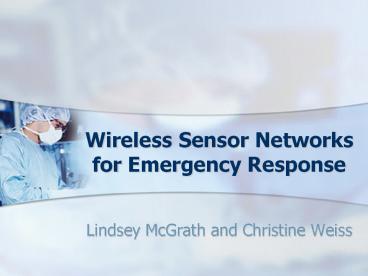Wireless%20Sensor%20Networks%20for%20Emergency%20Response - PowerPoint PPT Presentation
Title:
Wireless%20Sensor%20Networks%20for%20Emergency%20Response
Description:
Wireless Sensor Networks for Emergency Response Lindsey McGrath and Christine Weiss – PowerPoint PPT presentation
Number of Views:209
Avg rating:3.0/5.0
Title: Wireless%20Sensor%20Networks%20for%20Emergency%20Response
1
Wireless Sensor Networks for Emergency Response
- Lindsey McGrath and Christine Weiss
2
Agenda
- Introduction
- Components of Wireless Sensor Network (WSN)
- Existing Studies/Applications
- Potential Impact
- CodeBlue
- Challenges
- Conclusion
3
Introduction
- Sensor networks offer the medical community the
capability to capture, process and communicate
critical data through low-power, low-cost
wireless devices. - Applicable to various medical areas such as
patient monitoring, disaster response, and
rehabilitation monitoring
4
Components of WSN
- Data acquisition network and data distribution
network monitored and controlled by a management
center - Motes containing a tiny amount of CPU/memory
- PDAs and PC-class systems
5
Existing Studies/Applications
- Studies
- SMART
- AID-IN
- WiiSARD
- Patient Centric Network
- Agent Based Casualty Care
- Applications
- Habitat monitoring Great Duck Island
- WINS - military
6
Potential Impact
- Mass Casualty Events (MCE)
- Active Triage Tag
- Bridge the gap between patient load and available
resources - Simultaneous physical environment monitoring
- Tracking first-responder and patients location
and status - Creation of valuable medical research data
7
CodeBlue
- Harvard University in collaboration with various
medical facilities introduce CodeBlue - CodeBlue - An ad hoc WSN Infrastructure for
Emergency Medical Care - Goal Enhance first-responders ability to
access patients on scene, ensure seamless
transfer of data among caregivers, and facilitate
efficient allocation of hospital resources
8
CodeBlue Infrastructure
9
CodeBlue VitalDust
- Wearable wireless pulse oximeter and 2-lead
Electrocardiogram Monitor (EKG) - Collect heart rate (HR), blood oxygen saturation
(SpO2), and hearts electrical activity - Devices can be programmed to alert medical
personnel when vital signs fall outside normal
conditions
10
CodeBlue VitalDust Implementation
- Pulse Oximeter
- Mote-based oximeter connector betweenMica2/MicaZ
mote platform and the BCI Medical board - Measures the amount of light transmitted through
a noninvasive sensor attached to the patients
finger - How is the data used?
11
CodeBlue VitalDust Implementation
- EKG
- Mote-based EKG consists of a custom built
circuit board attached to aMica2/MicaZ/Telos
mote - Measures hearts electrical activity through a
set of leads attached to a patients heart at a
rate of 120 Hz - How is it used?
12
CodeBlue Pluto
- Wearable tag wristband
- Stores patient information and tracks patient
location using radio-frequency (RF) signals - Mote includes an external push button that can be
used by a patient to transmit a one-way alert to
medical staff
13
CodeBlue Pluto Implementation
- Pluto
- Based on Telos, containsa TI microprocessor,
ChipCon radio, rechargablebattery and a Mini-B
USBconnector - Provides Telos capabilities sacrificing
expandability and long battery life in favor of
smaller, light-weight design - How is it used?
14
CodeBlue MoteTrack
- Two-phase process to estimate locations
- Offline collection of RF signal signatures
followed by online location estimation - Operates in decentralized, robust fashion
providing good location accuracy despite minimal
failures in its infrastructure
15
CodeBlue MoteTrack Implementation
- MoteTrack
- Operates using low power, single chip radio
transceivers located in sensor network nodes
embedded in a wearable sensor - Receives messages as signatures from beacon nodes
populating an area - How is it used?
16
Challenges
- Communication Challenges
- Secure, reliable, ad hoc communication among
groups of sensors and mobile devices - Prioritize transmission of data
- Computational Challenges
- Computational power
- Security and encryption techniques
- Programming Challenges
- Level of software services
17
Conclusion
- Extremely beneficial in disaster response
scenarios - Requires efficiency and accuracy improvement
- A step up in saving lives, creating valuable
medical research data, and allocation of medical
resources
18
Resources
- Division of Engineering and Applied Sciences,
Harvard University - CodeBlue Wireless Sensor Networks for Medical
Care - http//www.eecs.harvard.edu/mdw/proj/codeblue/
- Victor Shnayder, Bor-rong Chen, Konrad Lorincz,
Thaddeus R.F.Fulford-Jones and Matt Welsh. Sensor
Networks for Medical Care. In the Harvard
University Technical Report TR-08-05, April 2005 - Konrad Lorincz, David Malan, Thaddeus R. F.
Fulford-Jones, Alan Nawoj, Antony Clavel, Victor
Shnayder, Geoff Mainland, Steve Moulton, and Matt
Welsh. Sensor Networks for Emergency Response
Challenges and Opportunities. In IEEE Pervasive
Computing, Special Issue on Pervasive Computing
for First Response, Oct-Dec 2004. - Thaddeus R. F. Fulford-Jones, Gu-Yeon Wei, and
Matt Welsh. A Portable, Low-Power, Wireless
Two-Lead EKG System. In Proceedings of the 26th
IEEE EMBS Annual International Conference, San
Francisco, September 2004. - David Malan, Thaddeus Fulford-Jones, Matt Welsh,
and Steve Moulton. CodeBlue An Ad Hoc Sensor
Network Infrastructure for Emergency Medical
Care. International Workshop on Wearable and
Implantable Body Sensor Networks, April 2004. - Konrad Lorincz and Matt Welsh. A Robust,
Decentralized Approach to RF-Based Location
Tracking. Technical Report TR-19-04, Harvard
University, 2004.































